Abstract
Today’s cryptography using RSA is faced with the problem of increased bit length and so called fast on-card key generation — both for security reasons. These two requirements often constitute a problem on existing cards as their arithmetic coprocessors are most often designed for a fixed bit length which is not suited for latest security demands. While the main problem, the overcoming of the computational limitations of the cards coprocessor can in principle be solved via recent efficient algorithms, the subproblem of computing the secret RSA exponents cannot be solved satisfactory by these algorithms. This is due to the fact that the key generation, including the secret RSA exponent, is done during the card personalization in the fab where production times are very costly. This article proposes a very simple, natural and efficient solution to this problem. Namely, computing the secret RSA exponent d via the Chinese Remainder Theorem (CRT) wrt. p − 1 and q − 1 where p and q denote the two secret primes of the the public modul N. We stress that it is impossible to use the CRT in a straightforward way, as p − 1 and q − 1 are not relatively prime. Nevertheless the solution to this problem is natural and very simple. However, as we have not found anywhere in the literature a hint on this very practical result, we felt to share it with the community.
Moreover, we present another method to compute efficiently secret RSA exponents d for certain short public keys e which we have not seen so far in the public literature.
Access this chapter
Tax calculation will be finalised at checkout
Purchases are for personal use only
Preview
Unable to display preview. Download preview PDF.
Similar content being viewed by others
References
E. Bach, J. Shallit, Algorithmic Number Theory, MIT Press, Cambridge MA, 1996.
D. Boneh, DeMillo, R. Lipton, “On the Importance of Eliminating Errors in Cryptographic Computations” Journal of Cryptology 14(2):101–120, 2001.
J.-S. Coron, P. Kocher and D. Naccache, Statistics and secret leakage, Proc. of Financial Cryptography’ 00, pp.-–-, 2000.
S. Cavallar et alii, Proc. of EUROCRYPT’ 00, Springer LNCS, vol. 1807, pp. 1–19, 2000.
C. Couvreur, J.-J. Quisquater, “Fast decipherment algorithm for RSA public-key cryptosystem”, Electronics Letters 18(21):905–907, 1982.
A. S. Fraenkel, “New proof of the generalized Chinese Remainder Theorem”, Proc. Amer. Math. Soc. 14:790–791, 1963.
C. F. Gauss, Disquisitiones Arithmeticae, G. Fleischer, Leipzig, 1801.
H. Handschuh, P. Pailler, “Smart Card Crypto-Coprocessors for Public-Key Cryptography”, CryptoBytes 4(1):6–11, 1998.
E. Hess, N. Janssen, B. Meyer, T. Schütze, “Information leakage attacks against smart card implementations of cryptographic algorithms and countermeasures”, Proc. of EUROSMART-Security-Conference 2000, pp. 53–64, 2000.
M. Joye, P. Pailler, S.-M. Yen, “Secure Evaluation of Modular Functions”, Proc. of 2001 International Workshop on Cryptology and Network Security, pp. 227–229, 2001.
D. E. Knuth, The Art of Computer Programming, Vol.2: Seminumerical Algorithms, 3rd ed., Addison-Wesley, Reading MA, 1999.
N. Koblitz, A Course in Number Theory and Cryptography, Springer, Berlin, 1994.
N. Koblitz, Algebraic Aspects of Cryptography, Springer, Berlin, 1999.
A. J. Menezes, P. van Oorschot, S. Vanstone, Handbook of Applied Cryptog-raphy, CRC Press, New York, 1997.
P. Pailler, “Low-cost double size modular exponentiation or how to stretch your cryptocoprocessor”, Proc. of Public Key Cryptography’ 99, Springer LNCS, vol. 1560, pp. 223–234, 1999.
R. Rivest, A. Shamir, L. Adleman, “A method for obtaining digital signatures and public-key cryptosystems”, Comm. of the ACM 21:120–126, 1978.
B. Schneier, Applied Cryptography, John Wiley & Sons, New York, 1996.
A. Shamir, “Method and Apparatus for protecting public key schemes from timing and fault attacks”, U.S. Patent Number 5, 991,415, November 1999.
Author information
Authors and Affiliations
Editor information
Editors and Affiliations
Rights and permissions
Copyright information
© 2002 Springer-Verlag Berlin Heidelberg
About this paper
Cite this paper
Fischer, W., Seifert, JP. (2002). Note on Fast Computation of Secret RSA Exponents. In: Batten, L., Seberry, J. (eds) Information Security and Privacy. ACISP 2002. Lecture Notes in Computer Science, vol 2384. Springer, Berlin, Heidelberg. https://doi.org/10.1007/3-540-45450-0_10
Download citation
DOI: https://doi.org/10.1007/3-540-45450-0_10
Published:
Publisher Name: Springer, Berlin, Heidelberg
Print ISBN: 978-3-540-43861-8
Online ISBN: 978-3-540-45450-2
eBook Packages: Springer Book Archive




